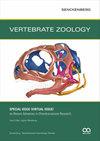The curious case of Charles Darwin’s frog, Rana charlesdarwini Das, 1998: Phylogenetic position and generic placement, with taxonomic insights on other minervaryan frogs (Dicroglossidae: Minervarya) in the Andaman and Nicobar Archipelago
IF 2.3
2区 生物学
Q1 ZOOLOGY
引用次数: 1
Abstract
Since the description of Charles Darwin’s frog as Rana charlesdarwini in 1998, its generic placement has been a taxonomic enigma. Subsequent studies first transferred this species to the dicroglossid genus Limnonectes, and then considered it as a ceratobatrachid of the genus Ingerana, which has since been moved to the family Dicroglossidae. However, recent works have doubted this generic placement and also suggested the possibility of its sister relationship with the genus Liurana, within Ceratobatrachidae. Nonetheless, there have been no detailed investigations to ascertain the generic placement of this taxon by confirming its phylogenetic position or using integrative taxonomic approaches. Here, we provide the first molecular assessment of Ingerana charlesdarwini based on mitochondrial and nuclear DNA and reveal that it is nested in the dicroglossid genus Minervarya. A member of the Minervarya andamanensis species group, Minervarya charlesdarwinicomb. nov. is sister taxon to M. andamanensis and shows relatively shallow genetic distances (2.8–3.6%) in the 16S gene. Both species are widely distributed, occur sympatrically, and exhibit high morphological variations, leading to long-standing confusions with other dicroglossid frogs reported from the region. Our combined morphological and molecular studies on dicroglossid frogs sampled across the known ranges of these species suggest that reports of Limnonectes doriae (Boulenger, 1887) and L. hascheanus (Stoliczka, 1870) from the Andamans are misidentifications of the former two, pointing to the absence of genus Limnonectes from the Andaman Islands. Our study also reveals the novel record of Minervarya agricola from the Andamans, a species that appears to have been confused with Fejervarya limnocharis and Minervarya keralensis in the literature and misidentified museum specimens, and is found to be widely distributed across these islands. We further find another congener from the Nicobar group of Islands, M. nicobariensis, to be closely related to M. charlesdarwini. Similar to the case of Andaman dicroglossids, our work emphasises on the need for further studies to ascertain the taxonomic identities and generic placement of Minervarya and Limnonectes species reported from the Nicobars.查尔斯·达尔文蛙的奇特案例,Rana charlesdarwini Das, 1998:安达曼和尼科巴群岛的其他密氏蛙(密氏蛙科:密氏蛙科)的系统发育位置和属位
自从1998年查尔斯·达尔文的蛙被描述为Rana charlesdarwin以来,它的属位一直是一个分类上的谜。随后的研究首先将这一物种转移到双革蛛属Limnonectes,然后将其视为Ingerana属的一种ceratobatrachid,该属后来被转移到双革蛛科。然而,最近的研究对这种属位提出了质疑,并提出了它与角鼻蛙属(Ceratobatrachidae)中Liurana属的姐妹关系的可能性。然而,目前还没有详细的调查来确定该分类单元的属位,通过确认其系统发育位置或使用综合分类方法。在这里,我们提供了基于线粒体和核DNA的Ingerana charlesdarwini的第一个分子评估,并揭示了它是嵌套在双gloglossid属Minervarya。密氏密氏菌属(Minervarya charlesdarwinicomb)的一员。11 .与M. andamanensis是姊妹类群,在16S基因上的遗传距离相对较浅(2.8-3.6%)。这两个物种分布广泛,共缘发生,并表现出高度的形态差异,导致长期与该地区报道的其他双舌蛙混淆。我们对这些物种已知分布范围内的双盲蛙进行了形态学和分子研究,结果表明,来自安达曼群岛的Limnonectes doriae (Boulenger, 1887)和L. hascheanus (Stoliczka, 1870)的报告是对前两者的误认,指出安达曼群岛没有Limnonectes属。我们的研究还揭示了来自安达曼群岛的Minervarya agricola的新记录,该物种似乎与文献和错误识别的博物馆标本中的Fejervarya limnocharis和Minervarya keralensis混淆,并且被发现广泛分布在这些岛屿上。我们进一步发现来自尼科巴群岛群的另一个同系种M. nicobariensis与M. charlesdarwin有密切关系。与安达曼双足化石的情况类似,我们的工作强调需要进一步研究以确定来自尼科巴群岛的Minervarya和Limnonectes物种的分类身份和属位。
本文章由计算机程序翻译,如有差异,请以英文原文为准。
求助全文
约1分钟内获得全文
求助全文
来源期刊

Vertebrate Zoology
ZOOLOGY-
CiteScore
4.00
自引率
19.00%
发文量
42
审稿时长
>12 weeks
期刊介绍:
Research fields covered by VERTEBRATE ZOOLOGY are taxonomy, morphology, anatomy, phylogeny (molecular and morphology-based), historical biogeography, and palaeontology of vertebrates.
 求助内容:
求助内容: 应助结果提醒方式:
应助结果提醒方式:


